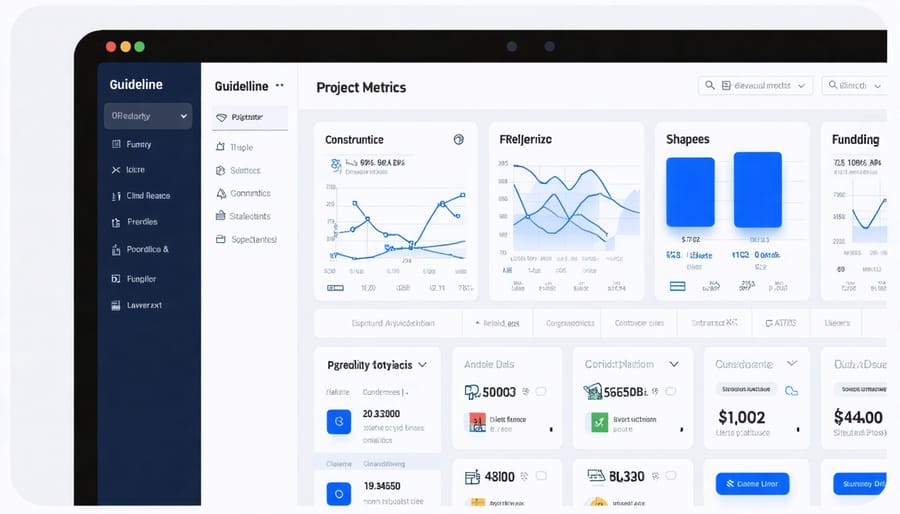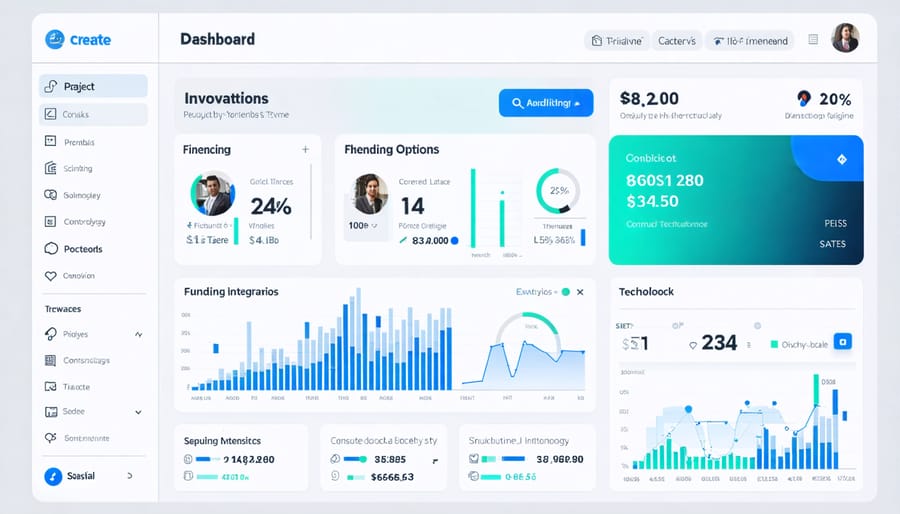Revolutionizing construction finance demands a fundamental shift from traditional lending models to innovative capital solutions that address modern building challenges. Digital financing platforms now enable contractors to secure project funding within days instead of months, while integrated payment systems streamline cash flow management across complex supply chains. The emergence of green financing instruments has created new opportunities for sustainable construction projects, offering preferential rates for developments that meet strict environmental criteria. Advanced fintech solutions, combined with data-driven risk assessment models, are transforming how construction firms access capital, manage working capital, and structure project financing in an increasingly competitive market.
This transformation comes at a crucial time, as the construction industry faces unprecedented challenges in material costs, labor shortages, and project complexity. Forward-thinking firms leveraging these innovative financing mechanisms gain significant competitive advantages: faster project initiation, improved cash flow management, and enhanced ability to tackle larger, more complex developments. By embracing these new financial tools and technologies, construction companies can better position themselves for sustainable growth while minimizing traditional financing bottlenecks that often delay project completion and impact profitability.
The Rise of Alternative Construction Financing
Project-Specific Financing Platforms
Recent innovations in financing technology have introduced specialized digital lending platforms that cater specifically to construction projects. These platforms leverage data analytics and artificial intelligence to streamline loan applications, assess project viability, and manage disbursements more efficiently than traditional financing methods.
Construction-specific financing platforms typically offer features such as progress-based payments, automated compliance tracking, and integrated project management tools. They enable real-time monitoring of project financials, helping stakeholders maintain better control over cash flow and reduce payment delays. Many platforms also incorporate supply chain financing options, allowing contractors to secure materials and equipment without straining their working capital.
Notable advantages include faster approval processes, customized repayment schedules based on project milestones, and reduced documentation requirements through digital verification systems. These platforms often integrate with existing project management software, creating a seamless workflow for financial tracking and reporting. For larger projects, some platforms offer syndication capabilities, allowing multiple lenders to participate in funding while maintaining a single point of contact for the borrower.

Public-Private Partnerships (P3)
Public-Private Partnerships have emerged as a powerful financing mechanism in modern construction, combining government oversight with private sector efficiency. These partnerships typically involve a private entity financing, designing, building, and operating public infrastructure projects while sharing risks and rewards with public agencies.
Recent P3 models have evolved to include performance-based payments, revenue-sharing arrangements, and innovative risk allocation structures. For example, availability payments have gained traction, where private partners receive regular payments based on meeting specific performance metrics rather than relying solely on user fees or toll revenue.
The benefits of P3s extend beyond mere financing. They accelerate project delivery, optimize lifecycle costs, and leverage private sector expertise. Studies show that P3 projects are 73% more likely to be completed on time compared to traditional procurement methods. Additionally, these partnerships often result in better maintenance outcomes due to long-term private sector commitment.
Key success factors include clear risk allocation, transparent procurement processes, and strong legal frameworks. Modern P3s increasingly incorporate sustainability requirements and technology integration, ensuring projects meet both current needs and future environmental standards.
Tech-Driven Financial Solutions

Blockchain and Smart Contracts
Blockchain technology is revolutionizing construction financing by introducing unprecedented levels of transparency, security, and efficiency. Smart contracts, self-executing agreements written in code, are particularly transformative in streamlining payment processes and reducing disputes between stakeholders.
In construction projects, blockchain creates an immutable record of transactions, milestones, and deliverables. This distributed ledger technology enables real-time verification of payment conditions, automated releases of funds, and precise tracking of material deliveries. For example, when a contractor completes a predetermined milestone, smart contracts can automatically trigger payments, eliminating payment delays and reducing administrative overhead.
Several leading construction firms have implemented blockchain-based payment systems, reporting up to 75% reduction in payment processing time and significant decreases in payment-related disputes. The technology also facilitates supply chain financing by creating transparent, verifiable records of material deliveries and installations.
Smart contracts are particularly effective in managing complex project financing structures, such as syndicated loans and performance-based payments. They can automatically enforce compliance with loan covenants, monitor project progress, and adjust payment schedules based on predetermined criteria.
However, successful implementation requires careful consideration of technical infrastructure, regulatory compliance, and stakeholder training. Construction companies should start with pilot projects to test blockchain solutions before full-scale deployment, ensuring all participants understand the technology’s capabilities and limitations.
AI-Powered Risk Assessment
Artificial intelligence is revolutionizing risk assessment in construction financing, enabling lenders to make more informed decisions while helping contractors secure funding more efficiently. Modern AI algorithms analyze vast datasets, including historical project performance, market conditions, and contractor track records, to generate comprehensive risk profiles within minutes.
These sophisticated systems evaluate multiple risk factors simultaneously, including project complexity, location-specific challenges, and economic indicators. By processing thousands of previous construction projects, AI can identify patterns and potential risks that might escape traditional analysis methods, leading to more accurate risk predictions and better-structured financing solutions.
Construction companies benefit from this technology through faster approval processes and more tailored financing terms. AI-powered systems can automatically adjust interest rates and loan conditions based on real-time risk assessments, creating more dynamic and fair lending practices. For example, contractors with strong performance histories and well-planned projects may receive more favorable terms, even if they don’t meet traditional lending criteria.
Risk management capabilities have also improved significantly, with AI systems monitoring project progress and flagging potential issues before they become critical problems. These early warning systems allow both lenders and borrowers to take proactive measures, reducing the likelihood of project delays or financial difficulties.
Financial institutions using AI-powered risk assessment report up to 30% reduction in default rates and a 40% increase in approval speed for construction loans, demonstrating the technology’s transformative impact on the industry.

Sustainable Finance Solutions
Green Bonds and ESG Financing
Green bonds and ESG-linked financing have emerged as powerful tools for construction companies to access preferential funding rates while demonstrating their commitment to sustainability. These instruments typically offer interest rate reductions of 0.25% to 0.75% when projects meet specific environmental, social, and governance criteria.
Leading construction firms are increasingly incorporating green building certifications like LEED and BREEAM into their financing strategies. By meeting predetermined sustainability targets, companies can secure more favorable lending terms while enhancing their market reputation. For example, major developers have successfully funded LEED Platinum-certified commercial buildings through green bonds, resulting in financing costs up to 50 basis points lower than conventional loans.
ESG-linked loans are particularly attractive for retrofit projects and sustainable infrastructure development. These facilities tie interest rates to measurable sustainability metrics such as carbon emissions reduction, waste management efficiency, and renewable energy integration. Construction companies can benefit from step-down pricing when meeting these targets, effectively reducing their cost of capital while advancing their sustainability goals.
To maximize these benefits, firms should develop robust sustainability reporting frameworks and maintain transparent communication with financial institutions regarding their ESG performance.
Energy Performance Contracting
Energy Performance Contracting (EPC) represents a groundbreaking approach to energy efficiency financing that aligns contractor incentives with building performance outcomes. Under this model, Energy Service Companies (ESCOs) implement comprehensive efficiency improvements while guaranteeing specific energy savings over a set period. The contractor assumes the performance risk, making this solution particularly attractive for organizations with limited capital budgets.
The financing structure typically allows building owners to fund improvements through the guaranteed future energy savings, effectively making the project self-funding. Implementation costs are repaid through documented reduction in utility bills, operational expenses, and maintenance costs. This arrangement ensures that technical and financial risks are transferred to the ESCO, while building owners benefit from immediate efficiency gains without upfront capital expenditure.
Recent industry data indicates that EPC projects achieve average energy savings of 15-30%, with some exemplary cases reaching up to 50% reduction in energy consumption. These contracts typically span 5-15 years, providing long-term stability and predictable cost savings for building owners while driving sustainable construction practices.
Risk Mitigation Strategies
Project Insurance Innovations
The construction insurance landscape is evolving rapidly, introducing innovative products designed to address modern project complexities and risk profiles. Parametric insurance solutions have emerged as a game-changer, offering predetermined payouts based on specific triggering events such as weather delays or material price fluctuations, streamlining the claims process significantly.
Project-specific environmental insurance now includes comprehensive coverage for sustainable construction methods and green building certifications, protecting against unique risks associated with emerging eco-friendly technologies and materials. These policies often feature additional provisions for renewable energy installations and carbon offset requirements.
Technology-driven insurance products are gaining traction, with IoT-enabled coverage options that utilize real-time data from construction sites to adjust premiums dynamically. Smart sensors and monitoring systems help insurers assess risk more accurately while potentially reducing premiums for well-managed projects.
Wrap-up insurance programs have become more sophisticated, offering integrated solutions that combine traditional coverage with innovative features like supply chain disruption protection and cyber security coverage. These comprehensive packages are particularly valuable for large-scale projects with multiple stakeholders.
Modular construction insurance products have also emerged, specifically designed to address the unique risks associated with off-site manufacturing and assembly. These policies provide seamless coverage across manufacturing facilities, transportation, and on-site installation phases, ensuring continuous protection throughout the project lifecycle.
Supply Chain Finance Solutions
Supply chain finance (SCF) solutions have emerged as a crucial tool for construction companies seeking to optimize their working capital and strengthen supplier relationships. These innovative financing mechanisms enable contractors to better manage material costs while providing suppliers with faster payment options, creating a win-win situation for all parties involved.
One key approach is reverse factoring, where construction companies leverage their strong credit ratings to help suppliers access financing at preferential rates. This arrangement allows suppliers to receive early payments while contractors can extend their payment terms, effectively improving cash flow management without straining supplier relationships.
Dynamic discounting programs offer another powerful solution, enabling construction firms to pay suppliers early in exchange for graduated discounts. This flexibility helps companies optimize their cash positions while supporting their supply chain partners’ financial health.
Digital platforms have revolutionized SCF implementation, providing real-time visibility into payment statuses, automated approval workflows, and seamless integration with existing accounting systems. These platforms enable construction companies to track material costs, manage payment schedules, and maintain transparent communication with suppliers.
Industry leaders are increasingly adopting blockchain-based SCF solutions, which offer enhanced security, reduced fraud risk, and automated smart contracts. This technology ensures transparent tracking of materials and payments while significantly reducing processing times and administrative costs.
For optimal results, construction companies should assess their supply chain needs, evaluate available SCF options, and implement solutions that align with their financial objectives and supplier relationships.
The construction industry stands at a pivotal moment in its evolution of financing solutions. As we’ve explored throughout this article, innovative financing mechanisms are reshaping how projects are funded, managed, and delivered. The integration of technology-driven solutions, such as blockchain-based smart contracts and AI-powered risk assessment tools, continues to streamline financial processes and enhance transparency.
Looking ahead, we can expect further democratization of construction financing through crowdfunding platforms and increased adoption of green financing instruments. The growing emphasis on sustainable development will likely drive more financial institutions to offer specialized products for eco-friendly construction projects, while digital lending platforms will continue to bridge the gap between traditional banking and modern construction needs.
Industry leaders should prepare for a future where hybrid financing models become the norm, combining traditional lending with alternative funding sources. The success of pilot programs in peer-to-peer lending and tokenized real estate investments suggests these innovative approaches will gain broader acceptance in the coming years.
To remain competitive, construction companies must stay informed about emerging financing options and develop strategies to leverage these tools effectively. Those who embrace these innovations while maintaining sound financial management practices will be best positioned to thrive in an increasingly dynamic construction landscape. The future of construction financing lies in adaptability, technological integration, and sustainable practices, marking an exciting era of transformation for the industry.

